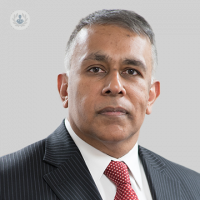What is lens replacement surgery and why would you have this procedure?
Escrito por:Lens replacement surgery is also called clear lens extraction or refractive lens exchange and is an operation which is done to correct the vision, which would otherwise be corrected with glasses or contact lenses. Professor Sunil Shah, a leading ophthalmologist, explains what lens replacement surgery is and how the procedure is performed.

Lens replacement surgery is similar to cataract surgery, except that with cataract surgery a cloudy lens which is stopping the vision is removed, whereas with refractive lens exchange what one is trying to do is replace a clear lens or a near clear lens with an intraocular lens, which corrects both the distant and near vision. This procedure is usually an option for patients who do not qualify for laser eye surgery techniques, such as LASIK.
How is lens replacement surgery carried out?
Your natural lens is similar to the size and shape of a Smartie. So, this is like having a Smartie within the eye which is suspended by ligaments to help it work. In lens replacement surgery, what we do is open up the front of the Smartie, so break open the candy, effectively take the chocolate out which is the contents of your natural lens, and in that space, that is created we put in an artificial lens. The artificial lens is usually acrylic.
There are a number of ways that we can achieve this. The traditional method is called phacoemulsification, which has been around for many years. This is done through a very small incision of around about two millimetres which allows us to access the lens.
The newer technique is called Femtosecond laser lens surgery. Here we use a Femtosecond laser to do the incision on the cornea. The laser makes the incision and then it breaks open the after it has imaged the eye and then it breaks down the lens before it finally has to be removed from inside the eye.
There are a number of other options that you can consider when having refractive lens exchange or clear lens extraction. One is to have one eye done at a time or you can have both eyes done at the same time. This is something that I would discuss with you, but I find that more than half of my patients want to have both eyes done on the same day.
We also need to discuss what sort of intraocular lens you put in. Traditionally, if you have a cataract operation and you have a single vision lens that can be chosen to focus usually for distance or for near vision, but it will only have one real focus point. Therefore, there are better types of lenses which one can use and the most commonly used type is called a multifocal lens, which then gives you distance and near vision. If you don't use such a lens, then you would not be able to get two distances to be able to see at the same time. In patients with astigmatism, we also use toric lenses. So, if you have a lot of astigmatism, then we need to use a lens which corrects your astigmatism.
What is the recovery like after having lens replacement surgery?
The recovery after lens replacement surgery varies depending on whether you have had one eye done or both eyes done. If you have had one eye done, some people have some difficulty in that they have one eye which is corrected for distance and the other one still has the same glasses or contact lenses prescription that they had before. The only way to tackle this is to wear a contact lens in the eye which hasn't been operated on.
Generally, if we're doing two eyes together then the vision is quite blurry on the first day of surgery, where you have enough vision to get around, but we recommend that you take it relatively easy. By the next day the vision is generally quite reasonable and improves a lot over the period of a week. We normally recommend that you have a week when things are relatively quiet and you do not drive until we tell you that you are legal to.
There should not be any pain. There will obviously be some discomfort and some watering and redness, but if any pain was experienced, we would want to see you to see why this is the case.
Will you need glasses after lens replacement surgery?
Lens replacement surgery is based on a calculation of what intraocular lens you need. We are also dependent on the healing of your eye, therefore, one cannot promise that one would be glasses-free after surgery. We are all obviously aiming that you have as good vision as possible, but realistically, one should expect to be 85 to 90% glasses-free.
So, what does that mean? In practical terms, one may need to have a pair of glasses in the car for driving, because if you're not quite at the legal limit or you're not as sharp as you might otherwise want, then you can wear the glasses just as a top-up. At the other end of the spectrum, one may need glasses for very small prints or tasks like threading a needle. Whilst the implants give you good near vision, it may not give you as good near vision as you were used to with your glasses or contact lenses, because these lenses work in a different way and they have a slightly different working distance to what you may be used to.
The lenses are designed to give you freedom from glasses or contact lenses, but they are not a perfect solution and you may need some glasses for occasional use.
If you are interested in lens replacement surgery, make an appointment with a specialist.


